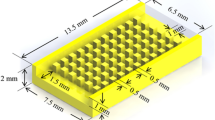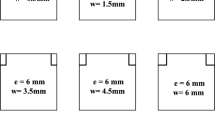Abstract
An experimental investigation has been performed to determine the effects of different arrangements of obstacles on the cooling of simulated electronic package. The considered simulated electronic package consisted of a channel formed by two parallel plates. The bottom plate is attached with five identical electrically heated square obstacles, which are perpendicular to the mean airflow and arranged with different side-to-side distances. The experimental results show that the conventional equi-spaced arrangement might not be the optimum option and should be avoided. A better thermal performance could be obtained when the side-to-side distances between the obstacles followed a geometric series. For example, at Re=800, the highest temperature of the optimum arrangement could be reduced by 12% compare to the equi-spaced arrangement and the maximum temperature difference among the five obstacles is lower than that of equi-spaced arrangement by 32.1%.
Similar content being viewed by others
Author information
Authors and Affiliations
Additional information
Received on 17 December 1999
Rights and permissions
About this article
Cite this article
Chen, S., Liu, Y., Chan, S. et al. Experimental study of optimum spacing problem in the cooling of simulated electronic package. Heat and Mass Transfer 37, 251–257 (2001). https://doi.org/10.1007/s002310000168
Issue Date:
DOI: https://doi.org/10.1007/s002310000168




